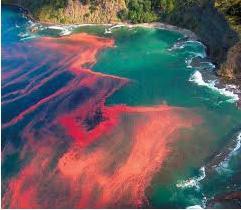Earth is full of natural beauties and I don’t think that any one can see all of those in life. From huge forests to marine life, from mountains to deserts the Earth shares its beauty with us.
We had made a list of such amazing wonders, which are less about places and more about formations and events.
1 – Ice Circles
It’s a rare fact that ice circle occur in slow moving water in cold climates. Ice circles are the large ice discs that rotate slowly in the water. It is believed that they form in eddy currents.
Ice circles are mostly observed in Scandinavia and North America, but in January 2009 one was also recorded in Britain.
2 – Red Tides
Red tide is a common name for a observable fact but correctly its known as an algal bloom, the event in which estuarine, marine, or fresh water algae rapid increase in the water column and results in discoloration of the surface water.
That can be seen only in coastal areas where algae are present in high concentrations.
3 – Columnar Basalt
Columnar Basalts are the rock formations that came in to existent from quick cooling of lava flow.
The most famous basalt flow in the world is the Giant’s Causeway in Northern Ireland; on this basalt the vertical joints form polygonal columns from its appearance it seems as it’s built artificially.
4 – Sun Dogs
Sun Dogs are the particular type of ice halo. This is a colored patch of light at left or right of the sun, 22 degrees distant and at the same distance above the horizon as the sun. That is most usually or 2nd most commonly seen of the ice halos.
Anywhere in the world in any seasons sundogs can be seen. In Europe or USA the can be seen once or twice in a week they are seen best when the sun is low.
5 – Moeraki Boulders
The Moeraki Boulders are large and spherical boulders lying Koekohe Beach on the wave cut Otago coast of New Zealand between Moeraki and Hampden. Those boulders are scattered on the stretch of the beach where they have been protected in scientific reserve.
The main aspect of these boulders is that they are unusually in the size and highly spherical in shape.
6 – Penitentes
Penitentes are the snow formation usually found on high altitudes. They look like tall thin blades of hardened snow, positioned closely and blades oriented towards the general direction of the sun.
Height of penitentes can be same as a person’s height. Darwin described them in 1839. When on March 22, 1835 he have to squeeze his way through snowfields covered in penitentes near the Piuquenes Pass, on the way from Santiago de Chile to the Argentinean city of Mendoza.
7 – Light Pillars
Light Pillars a visual occurrence created by the reflection of light from ice crystals with near horizontal parallel planar surfaces. Light pillars usually occur because of sunlight but moonlight and strong artificial light can also form light pillars.
The pillars look like the feather of the light that vertically lay out above or below the light source. When the sun is low on the horizon then most sun pillars can be seen.
8 – Catatumbo lightning
World’s largest single generator of Ozone is Catatumbo lightning in Venezuela. This is a cloud storm which forms a voltaic arc above the height of 5km, during 140 to 160 nights a year, 10 hours per day and up to 280 times per hour, over the area where Catatumbo River flows into the Lake Maracaibo.
Catatumbo Lightning can be seen from hundreds of miles away from the lake that is also known as Lighthouse of Maracaibo.
9 – Cave of the Crystals
Cave of Naica Mine is known as the Cave of the crystals. It’s located in Chihuahua, Mexico. This cave contains giant selenite crystals, some these are the largest natural crystals ever found.
The largest crystal in the cave is 26 ft in length, 36 ft in diameter and 55 tons in weight. The cave is about 98 feet in length and 33 ft in width. It’s extremely hot with air temperatures reaching up to 109F with 90 to 100 percent humidity. Without proper protection human can survive only ten minutes in this cave because of extreme temperatures.
10 – Pink and White Terraces
Pink and White Terraces were located in New Zealand but unfortunately they were destroyed by the violent volcanic eruption of Mount Tarawera in 1886.
Geothermally heated water with large amounts of siliceous sinter that regularly spouted for two geysers located beside Lake Rotomahana and small waterfall on a hill slope, leaving thick pink and white silica, which formed terraces in the shape of water pools.
The white terraces were more beautiful and were covering a large area about 3 hectares and descending 30 meters, while people went to Pink terraces to bathe.
















0 comments:
Post a Comment